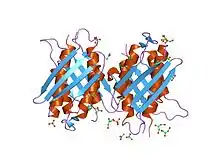Imidazoleglycerol-phosphate dehydratase
The enzyme imidazoleglycerol-phosphate dehydratase (EC 4.2.1.19) catalyzes the chemical reaction
- D-erythro-1-(imidazol-4-yl)glycerol 3-phosphate 3-(imidazol-4-yl)-2-oxopropyl phosphate + H2O
| imidazoleglycerol-phosphate dehydratase | |||||||||
|---|---|---|---|---|---|---|---|---|---|
 | |||||||||
| Identifiers | |||||||||
| EC no. | 4.2.1.19 | ||||||||
| CAS no. | 9024-35-5 | ||||||||
| Databases | |||||||||
| IntEnz | IntEnz view | ||||||||
| BRENDA | BRENDA entry | ||||||||
| ExPASy | NiceZyme view | ||||||||
| KEGG | KEGG entry | ||||||||
| MetaCyc | metabolic pathway | ||||||||
| PRIAM | profile | ||||||||
| PDB structures | RCSB PDB PDBe PDBsum | ||||||||
| Gene Ontology | AmiGO / QuickGO | ||||||||
| |||||||||
| Imidazoleglycerol-phosphate dehydratase | |||||||||
|---|---|---|---|---|---|---|---|---|---|
 crystal structure of imidazole glycerol phosphate dehydratase | |||||||||
| Identifiers | |||||||||
| Symbol | IGPD | ||||||||
| Pfam | PF00475 | ||||||||
| Pfam clan | CL0329 | ||||||||
| InterPro | IPR000807 | ||||||||
| PROSITE | PDOC00738 | ||||||||
| SCOP2 | 1rhy / SCOPe / SUPFAM | ||||||||
| |||||||||
This enzyme belongs to the family of lyases, specifically the hydro-lyases, which cleave carbon-oxygen bonds. The systematic name of this enzyme class is D-erythro-1-(imidazol-4-yl)glycerol-3-phosphate hydro-lyase [3-(imidazol-4-yl)-2-oxopropyl-phosphate-forming]. Other names in common use include IGP dehydratase, and D-erythro-1-(imidazol-4-yl)glycerol 3-phosphate hydro-lyase. This enzyme participates in histidine metabolism as it is involved in the 6th step of histidine biosynthesis as part of a nine step cyclical pathway.
There are two isoforms of IGPD; IGPD1 and IGPD2. The different isoforms are highly conserved with only 8 amino acids differing between them. These subtle differences however affect their activity but as yet it is unknown how.
In most organisms IGPD is a monofunctional protein of about 22 to 29 kD. In some bacteria such as Escherichia coli, it is the C-terminal domain of a bifunctional protein that include a histidinol-phosphatase domain.[1] In E. coli, this is the protein encoded by the hisB gene.[2]
Inhibition
Certain compounds that inhibit IGPD have been used as herbicides as animals do not have this protein. One of these inhibitors is 3-Amino-1,2,4-triazole (3-AT), which has also been used as a competitive inhibitor of the product of the yeast HIS3 gene (another IGPD), e.g. in the yeast two-hybrid system.[3][4]
Structural studies
As of late 2007, 3 structures have been solved for this class of enzymes, with PDB accession codes 1RHY, 2AE8, and 2F1D.[5]
References
- Carlomagno MS, Chiariotti L, Alifano P, Nappo AG, Bruni CB (October 1988). "Structure and function of the Salmonella typhimurium and Escherichia coli K-12 histidine operons". J. Mol. Biol. 203 (3): 585–606. doi:10.1016/0022-2836(88)90194-5. PMID 3062174.
- Brilli, M.; Fani, R. (2004). "Molecular Evolution of hisB Genes". Journal of Molecular Evolution. 58 (2): 225–237. Bibcode:2004JMolE..58..225B. doi:10.1007/s00239-003-2547-x. PMID 15042344. S2CID 1684458.
- Brennan, M. B.; Struhl, K. (1980-01-25). "Mechanisms of increasing expression of a yeast gene in Escherichia coli". Journal of Molecular Biology. 136 (3): 333–338. doi:10.1016/0022-2836(80)90377-0. ISSN 0022-2836. PMID 6990004.
- Cagney, G.; Uetz, P.; Fields, S. (2000). High-throughput screening for protein-protein interactions using two-hybrid assay. Methods in Enzymology. Vol. 328. pp. 3–14. doi:10.1016/s0076-6879(00)28386-9. ISBN 9780121822293. ISSN 0076-6879. PMID 11075334.
- Glynn SE, Baker PJ, Sedelnikova SE, Davies CL, Eadsforth TC, Levy CW, Rodgers HF, Blackburn GM, Hawkes TR, Viner R, Rice DW (2005). "Structure and mechanism of imidazoleglycerol-phosphate dehydratase". Structure. 13 (12): 1809–17. doi:10.1016/j.str.2005.08.012. PMID 16338409.
Further reading
- AMES BN (1957). "The biosynthesis of histidine; D-erythro-imidazoleglycerol phosphate dehydrase". J. Biol. Chem. 228 (1): 131–43. PMID 13475302.